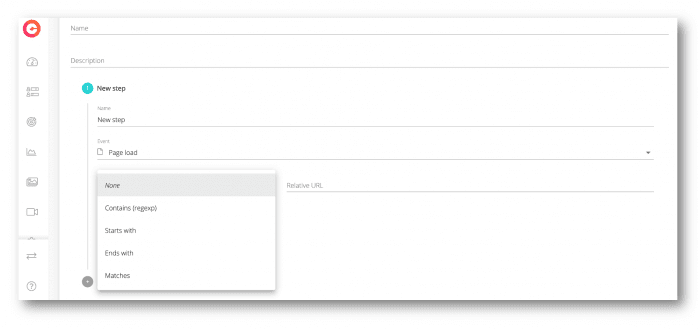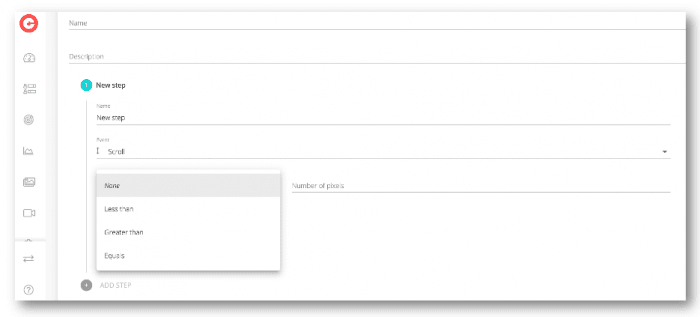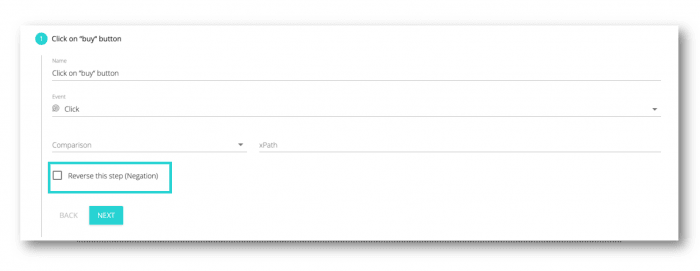Goal events
👉 Traffic tracking
Traffic tracking events help you use visitor activity related to web pages or navigation. They include events like page loading or tracking navigation origin (referrer).
Waterfall and Goal events: Traffic tracking
Page load
Use page loads to track when someone loads a page – visits a specific URL. Several page loads can be used for complex conversion tracking when users need to visit several pages before they reach a conversion goal.
Remember to enter a relative URL here! You can type in only a part of the address, usually a page name like cart.php or product.html.
Just because we wanted to make your life even easier, we’ve added some handy shortcuts to define a part of the page address:
- Contains (regexp) – You can use a regular expression to match a page name. This is useful when you want to record page loads whose URLs can vary depending on the use case, for example, the page name gets appended to different parameters.
If you type “product”, we’ll track visits with URL
✅ “/product.html”, “/product-1.html”, “/shoe-product.html”, “/product-promo.html” etc.
- Starts with – Type the beginning of the page address to see possible options.
If you type “/product”, we’ll track visits with URL
✅ “/product.html”, “/product-1.html”, “/product-promo.html”
❌ NOT “/shoe-product.html”
- Ends with – Type in the ending part of the page address to see the possible options.
If you type “product.html”, we’ll track visits with URL
✅ “/product.html”, “/shoe-product.html”
❌ NOT “product-1.html”, “product-promo.html”
- Matches – Type in the exact part of the page address you want to track.
If you type “/product.html”, we’ll only track visits with URL
✅ “/product.html”
❌ NOT “/product-1.html”, “/product-promo.html”, “/shoe-product.html”

Referrer
A problem-solver when it comes to tracking visitors coming to you from a specific, external addresses. Very useful while observing users popping on your site from social media or search engines. The value you need to enter here is the source address. Type in the entire URL or part of it.
Such nice fellows we are, here are dedicated shortcuts that will allow you to work with page names or their parts instead of complete URLs.
- Contains (regexp) – User regular expression to cover parts of the referrer address.
- Starts with – Type the beginning of the referrer address.
- Ends with – Type the ending of the referrer address.
- Matches – Type in the full URL of the referrer.
👉 Pointer
Pointer events are related to direct user actions on your page – whether it’s a click on a specific element or a page scroll.
Waterfall and Goal events: Pointer
Click
Click event allows you to base a step on specific elements that users click while navigating your pages like buttons, links, images, etc. You’ll need to enter the XPath of the element that receives clicks!
Scroll
The scroll event allows you to track users who vertically scrolled your website by a specific number of pixels. You can define the preferred scroll height in pixels to mark user action who gets to a particular area of the page, for example, below the fold.

NOTE: the pixels used in the Goal are calculated by the visitor browser. You need to verify these numbers by displaying the page using various screen resolutions. This is especially important if the code of your page uses relative units of measure like em or rem!
👉 Form
Those events help you follow visitor actions in form fields. These actions include putting the mouse cursor in the field, moving out of the field, or form submission.
Waterfall and Goal events: Form
You’ll need to enter the XPath to indicate a specific form element.

- Focus in. When users click or tab into a form field. The event is recorded regardless of the input device people use to navigate through your form – whether they use a mouse, keyboard, or other tools is not essential, as the primary thing here is the focus on the field.
- Changed. Whether someone edits a form, enters new data, or changes the field content. All typing, deleting, and overwriting match this event.
- Focus out. The event when someone moves the pointer out of a form field. You’ll see users stop typing in a field and moving forward.
- Submit. When someone clicks the submit button, and data entered in the form is sent to your server. The Submit event is more reliable than Click because it is based on the actual event of submitting the form and not just clicking a button.
NOTE: Submit may not work if you have opt-ins or Captcha to click. To be sure that the form was successfully submitted, add one more step – tracking the page-load of the form submission confirmation page.
👉 Reverse this step (Negation)
Waterfall and Goal events: Negation
Negation in the case of events means that CUX will select for you all the visits that did NOT meet the given Goal. For example, if you select an even “Click the “buy” button” and check the “Reverse this step (Negation)” box, you will only see the visits’ recordings where users did not fulfil the Goal (did not click the button).
